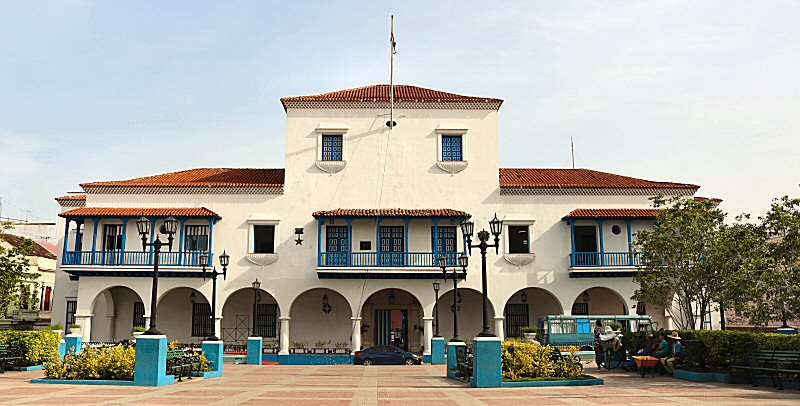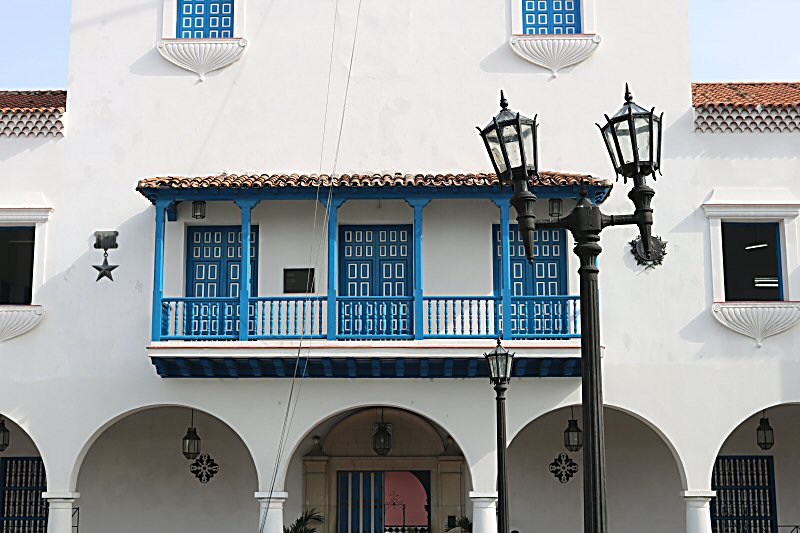
The
building has two levels with an interior patio that is surrounded
by galleries, covered with Creole tiles. A third level in the
center of the front serves as viewpoint. Continuous balconies,
Spanish-style wooden doors with nails and a facade with columns
and arches are other characteristics of the building.
During the establishment period
of the town Santiago de Cuba, a house was built by Diego
Velázquez on the north side of the current Parque
Céspedes in 1515. It functioned as his residence, as well as an
organ of the government and the administration (Casa del Gobierno). In fact, this building was
built to become independent from the governor of Santo Domingo,
because at that time Cuba was ruled from outside by the King of
Spain and the Council of Indies, but from the interior by the
governor of Santa Domingo. Many personages and captains of those
who arrived in Santiago de Cuba, stayed in this house. It was
used also as the mayoral office by Hernán Cortés Monroy, the first mayor of the city and
also the husband of the sister-in-law of Diego Velázquez.
Such a council house (ayuntamiento) is considered the first in the history of Cuba and the second in the whole America. The first building was constructed by cuje (long, flexible stem of a plant after its leaves has been removed; it was used to gather tobacco) and its roof by guano. The adjoining prison and the hospital were moved to other places of the city in 1776. This town house was reduced to ruins by an earthquake. The walls were rebuilt by stone and mud, and tiles were used for the roof. In 1830 the house was rebuilt by using bricks and tiles. In next years, the building underwent several transformations, so that Mayor Luís Casero ordered the construction of a new building (the current one) in 1952. The present building that was inaugurated by Mayor Maximo Torres in 1954, is a copy of the first house, adopted from old plans of the 18th century (the design of 1783) by Francisco Prat Puig. The building was destined to the Governor’s Palace, but it had never come true.
On 31
December 1901, the mayor Emilio Bacardí Moreau hauled down the
American flag from the mast at the central balcony and raised
the Cuban flag. In its memoriam, at 24:00 of each December 31, a
huge Cuban flag about 18 meters long is hung on the balcony of
the building in accompany of twelve chimes of the cathedral
(flag feast).
In
fact, this building is known by the Cubans to be the site from
where Fidel Castro spoke to the town for the first time and
proclaimed the victory over the regime of Batista on January 1,
1959 (Day of the Triumph of the Revolution). For his speech, he
used the balcony overlooking the park.
In
1984, on occasion of the celebration of the 25th Anniversary of
the Triumph of the Revolution, Fidel Castro made a speech from
the same place, awarding Santiago de Cuba the honorary titles of
Hero City of the Republic of Cuba and the Order of Antonio Maceo
Grajales. These plaques are hung on the façade of the building.
Since its foundation, the name of the town
hall has changed several times according to different historical
periods, such as cabildo (town hall), city hall (Palacio
Municipal), town hall (alcaldia), municipal commissioner (Comisionado
Municipal), and the Coordination of Execution and Inspection
Boards (JUCEI, las Juntas de Coordinación Ejecución e Inspección).
Currently this National Monument is not open to the public; it
is used by the state institution Municipal Assembly of People's
Power (Asambleas Municipales del
Poder Popular).

